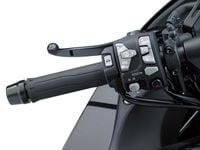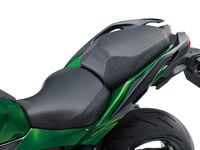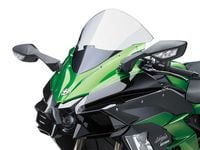We know what you're thinking. "The H2 SX is just an H2 with different bodywork and softer power settings in the ECU." Although it might look that way from a cursory glance, the SX is so different from its H2/H2R forebears when you get up close and then actually ride the thing, it really does deserve a look if you're interested in something a little more lively than the usual boring sport-tourers on the market. I've ridden both the H2 and H2R (as well as many other S-T bikes available), so I have a pretty good perspective on how the H2 SX SE fits in the grand scheme of motorcycling. Thinking along those lines, the following are my favorite and not-so-favorite aspects of Kawasaki's latest forced-induction marvel.
Getting blown is more fun.
Dyno/spec chart mavens like to dismiss the H2 SX’s numbers. “So what, my literbike makes more than that” or “My ’Busa/ZX-14R will put that to shame.” Yes, the numbers say that, but what they don’t show is how the H2 SX SE’s monster torque is constant once the engine is on boost; it doesn’t rise and fall with rpm like a literbike, and you’re not wrestling around with a big, heavy lump of engine and merchant-ship handling like a ’Busa or ZX-14R. Unlike the H2/H2R, the throttle response and powerband on the SX SE is nice and smooth, without the abrupt response when you get on the gas midcorner, and less of a monster surge when the boost builds. In other words, the H2 SX SE provides most of the same thrills as its supercharged brethren without the downsides and commitment.
Surprisingly excellent suspension.
The KYB fork and shock may look pretty unassuming, but their performance is anything but. We were blown away (pun intended) by the suspension’s ability to keep the H2 SX SE’s chassis stable and absorb most anything we threw at it. Big hits or small bumps, aggressive braking or big handfuls of throttle—nothing seemed to faze the suspension and cause things to start unraveling. A big plus is that the rear shock has a remote hydraulic preload adjuster to allow easy changes for a passenger and/or luggage, and it has both high- and low-speed compression damping adjustment in addition to the usual rebound damping and manual spring preload adjusters. If you had just jumped on the H2 SX SE without looking at the suspension, its performance is good enough to easily assume that it might be of Swedish origin.
The full-monty electronics suite.
The H2 SX SE comes with a modern electronics package that is chock-full of useful features. The Bosch five-axis IMU allows the KTRC traction control and KIBS antilock brake system to become much more precise and adaptable to riding scenarios, and the KQS quickshifter’s dual upshift/downshift ability makes twisty roads a lot more fun to play in. It’s definitely about time Kawasaki equipped one of its sport-touring bikes with cruise control, and it’s easy to see exactly what you’re adjusting on the full-color TFT info panel (on the flip side of the electronics kudos, we like that Kawasaki still fitted an analog tachometer on the H2 SX SE). Heated grips, progressive LED cornering lights…the list goes on.
Integrated optional hard saddlebags.
Although the excellent Kawasaki Genuine Accessories hard saddlebags are a $1,214.75 option (which includes mounting hardware, color-matched panels/striping, and a single-key lock system using your ignition key), they're definitely worth it in my opinion. Removal/install is a snap, and the integrated mounting system doesn't have any unsightly hardware if you decide to ride sans bags. Opening the bags is easy and doesn't require some sleight of hand with the key like some setups, and they hold a surprising amount of cargo despite how little they stick out on the sides. And we've ridden with these same type of bags on other Kawasakis, and can attest to their waterproofing on long, rainy rides.
The seat could definitely be better.
Even though it could be said that the H2 SX SE wasn’t meant to be cruised on long stretches of straight highway, we still found the seat became a little uncomfortable after about 40 minutes of riding. The forward portion has some cutouts to allow the rider’s legs to get a straighter shot at the ground, but that also starts cutting into your cheeks after a while. The standard H2 SX has a slightly different seat than the SE, and while we didn’t get a chance to spend any time on the standard SX, the seat felt slightly better than the snazzier-looking unit on the SE.
A bit more wind protection, please.
Anytime you put the words “touring,” “comfort,” or “journey” into a bike’s adspeak, I think the bike needs to deliver on some of the basics of that segment-defining category. And while it’s obviously meant to be on the sportier side of the sport-touring spectrum, the H2 SX SE falls a bit short on the wind protection front. The taller windscreen (which is optional on the standard SX) helps keep some of the wind blast off your chest, but your shoulders and hands feel exposed; on colder rides, you’ll be layering up pretty heavily for your torso to feel comfy, and while the grip heaters help (again, optional on the standard SX), it’s not a replacement for at least some wind protection in that area.
Premium price.
Yes, the H2 SX SE’s build quality is excellent, it packs a ton of electronics features, and it has a unique type of performance and desirability. But $22K puts it in a pretty exclusive club, and any sport-tourers approaching that price tag have way more practicality in their favor than the H2 SX SE. The standard SX is “just” $19,000, but some of the features that it lacks compared to the SX SE are big enough that we can’t see going for the no-frills version. The H2 and H2R have their own type of desirability that commands their much higher pricing, but is there really enough of a market for a supercharged sport-tourer that banks more on its exclusivity than its practicality?


















/cloudfront-us-east-1.images.arcpublishing.com/octane/VZZXJQ6U3FESFPZCBVXKFSUG4A.jpg)
/cloudfront-us-east-1.images.arcpublishing.com/octane/QCZEPHQAMRHZPLHTDJBIJVWL3M.jpg)
/cloudfront-us-east-1.images.arcpublishing.com/octane/HXOUJXQWA5HBHGRO3EMJIGFMVI.jpg)

/cloudfront-us-east-1.images.arcpublishing.com/octane/3TIWWRV4JBBOLDVGRYECVVTA7Y.jpg)
/cloudfront-us-east-1.images.arcpublishing.com/octane/KIX5O23D5NAIBGFXBN3327DKZU.jpg)
/cloudfront-us-east-1.images.arcpublishing.com/octane/7GJYDUIPXRGMTMQKN6ONYOLBOU.jpg)
/cloudfront-us-east-1.images.arcpublishing.com/octane/MUQLOVLL2ZDGFH25ILABNBXKTI.jpg)
/cloudfront-us-east-1.images.arcpublishing.com/octane/TNOU5DNE2BC57MFPMGN2EIDXAM.jpg)
/cloudfront-us-east-1.images.arcpublishing.com/octane/GTCXACQGJ5HAPDTGWUQKDEH44E.jpg)
/cloudfront-us-east-1.images.arcpublishing.com/octane/S35YGSEMEZB4BLTDJTSZPF4GLA.jpg)
/cloudfront-us-east-1.images.arcpublishing.com/octane/5UOT6HPX2JFMRJAX6EH45AR4MQ.jpg)
/cloudfront-us-east-1.images.arcpublishing.com/octane/OKWOJWAKP5EP3OACCRRWPCIX2Q.jpg)
/cloudfront-us-east-1.images.arcpublishing.com/octane/2WF3SCE3NFBQXLDNJM7KMXA45E.jpg)
/cloudfront-us-east-1.images.arcpublishing.com/octane/G4MG6OUCJNBSHIS2MVVOTPX65E.jpg)
/cloudfront-us-east-1.images.arcpublishing.com/octane/IIGGWFOTOJGB7DB6DGBXCCMTDY.jpg)
/cloudfront-us-east-1.images.arcpublishing.com/octane/QSTCM6AVEZA5JJBUXNIQ3DSOF4.jpg)
/cloudfront-us-east-1.images.arcpublishing.com/octane/U4I7G625B5DMLF2DVIJDFZVV6M.jpg)
/cloudfront-us-east-1.images.arcpublishing.com/octane/B6XD6LS6IVCQPIU6HXDJSM3FHY.jpg)
/cloudfront-us-east-1.images.arcpublishing.com/octane/ICL63FEDDRDTTMINYICCEYGMDA.jpg)
/cloudfront-us-east-1.images.arcpublishing.com/octane/FCGZHQXRBZFLBAPC5SDIQLVF4I.jpg)
/cloudfront-us-east-1.images.arcpublishing.com/octane/WNOB6LDOIFFHJKPSVIWDYUGOPM.jpg)

/cloudfront-us-east-1.images.arcpublishing.com/octane/X33NU3E525ECRHXLNUJN2FTRKI.jpg)